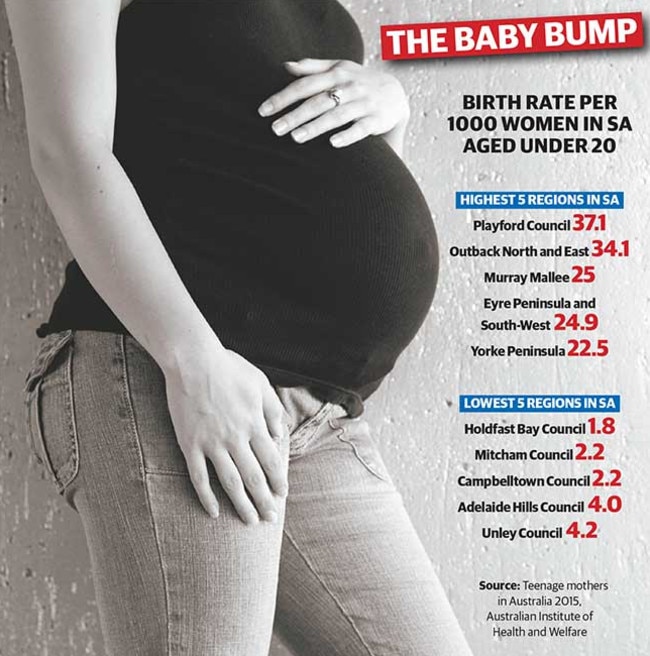New survey links teen pregnancy with socio-economic status
A SEX education overhaul is key to slowing rates of teen pregnancy, support agencies claim, as new figures reveal the areas of SA experiencing rates three times the national average.
SA News
Don't miss out on the headlines from SA News. Followed categories will be added to My News.
TEEN pregnancy rates are more than three times higher than the national average in the Playford Council area, in Adelaide’s northern suburbs, with pregnancy support services calling for an overhaul of sex education.
The number of teen mums in regional areas, including the Far North, Murray Mallee and Eyre Peninsula, were also significantly higher than the national average of 11.4 births per 1000 women aged under 20, a new study shows.
The Australian Institute of Health and Welfare’s first report on teenage mothers in Australia released earlier this month shows that while the number of teen pregnancies is falling, a significant socio-economic divide remained.
It found teen mums were nine times more likely to be living in the nation’s lowest socio-economic areas, with one in four teenage mums of indigenous background.
Adelaide-based teen pregnancy support services contacted by the Sunday Mail say high secondary school dropout rates, low self-esteem, family breakdown due to family abuse, domestic violence, drugs and alcohol, and sexual assault were prevalent factors contributing to higher teen pregnancy rates in lower socio-economic areas.

Vicki Lachlan, manager of family care centre Louise Place, said educators and parents needed to be more realistic about contraceptive use and sexual health knowledge among teens and start comprehensive sex education earlier as the age of first sexual encounter continues to fall.
“We have to be more realistic that young people are engaging in sexual activity much earlier than before and if they are doing it without proper sexual health education then we are setting them up for situations like teen pregnancy,” she said.
Genesis Pregnancy Support executive officer Juli Sharpe said most teens with unplanned pregnancies counselled by the non-government organisation were ignorant of or ambivalent to the consequences of sex.
“They just don’t think they will get pregnant,” Mrs Sharpe said.
“Or they are too timid and lack self-esteem and would rather have unprotected sex than upset their partner,” she said. “Sex education is very important. It should not just be about how to put a condom on but about the motivation to have sex, what a healthy relationship looks and feels like, and acceptable relationship boundaries.”
SA Commissioner for Children and Young People Helen Connolly said limited or no access to contraception and women’s health services, peer pressure, small-town stigma and a general lack of in-depth gender-based sex education were some of the barriers country and remote area teens had reported.
“Children and young people have told me that often teachers will be too embarrassed to talk about it in depth in country towns and when it’s taught it is taught as part of health and physical education in a very brief and mechanical way,” Commissioner Connolly said.
SA Education Department executive director of learning improvement Susan Cameron said puberty, reproduction, positive sexual health practices (including consent, STDs and contraception) were addressed in age-appropriate compulsory content from primary school to high school as part of the Australian Curriculum through resources provided by SHINE SA.
She said schools in which teen pregnancy was an issue were able to gain additional support and resources from SHINE SA to develop a specific response.
SHINE SA medical education co-ordinator Dr Amy Moten said a decrease in the teen pregnancy rate reflected better health information for young people, including education in schools and better access to health services.


